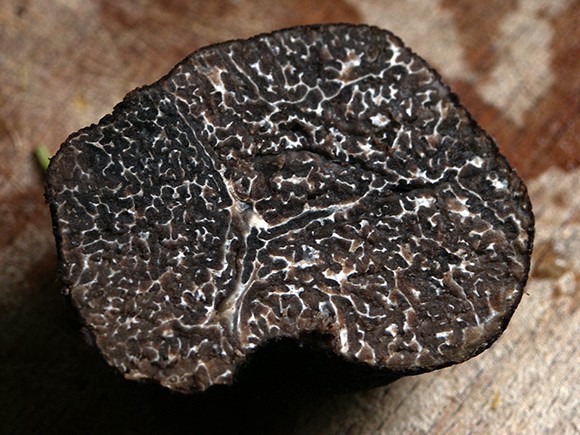A fungus among us: Team hopes to cultivate truffles on Central Coast
IN THIS ARTICLE
- Agribusiness Topic
- Marlize van Romburgh Author
By Marlize van Romburgh Friday, August 15th, 2014

The black winter truffle. A team of truffle farmers are hoping to build out large-scale production of the specialty crop on the Central Coast. (Wikimedia Commons photo)
A group of French and Chilean truffle farmers are sniffing out the Central Coast’s potential to grow the highly prized fungi.
A team from Beyond Truffles, a Chilean truffle producer, and Agri-Truffe, a French truffle-tree nursery operation, are reaching out to San Luis Obispo County farmers and vintners in hopes of launching large-scale production of the black winter truffle, a delicacy that can sell for upwards of $1,000 per pound.
By next season, the group hopes to have a truffle-tree nursery and 400 acres of truffle production in the ground in north San Luis Obispo County, Claudio Donoso, CEO and founder of Beyond Truffles, told the Business Times.
“We have our sales goals. We have our long-term plan for what [the Central Coast’s] truffle culture should be,” he said.
The group hopes to invest in land, nurseries and laboratories and work with researchers at Cal Poly San Luis Obispo to grow black winter truffles in California’s third-largest wine-growing region, which they say offers prime truffle-farming conditions.
The climate and soils in Paso Robles, Templeton and Atascadero share characteristics of some of the top-producing truffle plantations in France and South America, the group said in an Aug. 4 presentation at Cal Poly’s Technology Park.
The group is interested in growing black winter truffles, delicacies that can sell for thousands of dollars per pound. The drought-resistant fungi tend to grow best in areas that are also wine-growing regions, the presenters said.
“There’s this relationship between the wine and truffle, not just in the areas [where they grow] but between the taste,” said Pierre Sourzat, an agricultural researcher who is working with Beyond Truffles and Agri-Truffe and has led experimental truffle-growing ventures around the world.
The truffle group is hoping its presentation will spark interest among SLO County farmers, wine-grape growers and tourism officials.
Truffles have been grown for hundreds of years in Europe, but the exact formula for cultivating the fungi on a commercial scale is still somewhat of a mystery, Sourzat said. That means that around the world, truffle farmers have tried a variety of methods to produce the crop, with varying degrees of success.
France, home of the black winter truffle, has seen its market fall from about 360 tons annually at its peak in the late 1800s to about six tons a year more recently. Reasons for the decline range from over-cultivation and under-irrigation to a simple change in ecology, Sourzat said, with truffles often struggling to compete with other fungi in the areas where they are cultivated.
More recently, black winter truffle-growing regions have sprung up in Australia, New Zealand and Chile. China became a large truffle producer, but its industry has been on the decline as a result of over-harvesting, Sourzat said.
In the U.S., truffles have been successfully cultivated in a select few spots, including Oregon, Tennessee and North Carolina, where North Carolina State University has launched a truffle project through its agriculture college.
What is known about the black truffle is that it favors rich, well-aerated limestone soils and moderate climates. In areas that don’t naturally have a high limestone content, growers have been successful at adding lime to soil to boost its acidity.
While the black winter truffle is heat tolerant, it will die if exposed to prolonged drought or deep frosts at the peak of its growing season, Sourzat said. Most of the truffle’s growth occurs in the hottest months of summer and the crop is typically harvested in deep winter.
Donoso, who grew up in Santa Monica before embarking to Chile to begin truffle-farming, said he has long known about the Paso Robles area and has spent the last two years researching the region’s potential for truffle-growing. The group has set up operations in Templeton and plans to build its nursery and plant its first crops nearby.
“I pretty much knew this place before I knew about truffles,” he said. “It happens to provide the right conditions for truffle growing.”
North SLO County offers mild winters, well-aerated soils and an abundance of vintners, who can serve as experts on the local terroir, the group said. “Terroir is not just the soil and the climate, but the local collective knowledge in an area,” said Damien Berlureau, owner and CEO of Agri-Truffe. “We need people who know the terroir.”
Just as importantly, the area has many oak trees. Truffles naturally grow on the roots of oaks, but often struggle to outcompete other fungi there. “The oak is the best friend of the truffle and the worst enemy of the truffle,” Sourzat said.
Forty years ago, Agri-Truffe pioneered the process of mycorrhization to cultivate so-called truffle trees. Through the process, the roots of young trees — most commonly, oak and hazelnut — are infected with bacteria that begins the truffle’s growth. After getting their start in a nursery, the trees are planted and carefully cultivated to ensure the truffles flourish while competing fungi don’t. If successful, the tree and its truffles mature in a symbiotic relationship, with the tree giving the truffle essential nutrients and the fungus offering extra moisture and, in some cases, protection from disease.
There are several common methods of truffle farming, Sourzat said. Some truffle farms feature carefully cultivated orchards of trees, while others have open landscapes more akin to the natural environment. Still others feature a grove-like ecosystem that features trees grown on a lawn.
Donoso said various truffle cultivation methods could be tried in San Luis Obispo County and that Sourzat’s expertise will be key. He noted that truffles don’t require much water or labor — both inputs that have faced severe shortages on the Central Coast in recent years. “One person and two truffle dogs can take care of 25 acres,” Donoso said.
Truffles also produce a variety of offshoot economic activities, Berlureau said. In France, tourists from near and far flock to witness truffle foraging — either with trained dogs or pigs — and to attend truffle markets and festivals.
Truffle-dog breeding and training is a serious venture, with the mild-mannered and strong-nosed Italian breed the Lagotto Romagnolo a favored choice.
And then there’s the culinary culture that springs up around truffles and wine. Berlureau said he was recently in Paso Robles, enjoying beer and wine-tasting and checking out the terrain, which looked shockingly familiar. “I felt at home — I felt like I was back in France,” he said.












